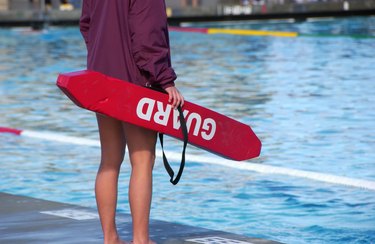
The physical fitness of lifeguards has a direct impact on their ability to perform rescues, whether working poolside or patrolling beaches and open water. A lifeguard workout should regularly include swimming and strength training exercises.
Beach lifeguards choose workouts that help them develop specific skills, such as swimming speed, so they can optimally perform their jobs. According to the American Red Cross, professional lifeguards should participate in regular swimming and water exercises that build endurance and strength.
Video of the Day
Video of the Day
Read more: 10 Safety Rules Every Swimmer Should Follow
1. Swimming
Due to the nature of their jobs, swimming ranks as the most important exercise for lifeguards. Rescue swimming must be fast and accurate so that lifeguards can reach victims quickly.
Typical lifeguard fitness training includes a warm-up followed by skills training, where lifeguards focus on stroke length, breathing techniques and specific rescue methods.
They might spend some time swimming at race-pace, but they often spend a larger percentage of time swimming at a steady, endurance-level pace.
On days when lifeguards sprint-train in the water, they may also perform a strength training session or run a few miles. Beach lifeguards often do combination swim-run or row-swim workouts.
2. Running
Running, like swimming, is another functional exercise for lifeguards, especially those who patrol open water and have to cover land distance before reaching the water.
Daily training sessions are mandatory for lifeguards at Hampton Beach in New Hampshire. These sessions incorporate swimming sprints and running sprints in a single lifeguard workout.
3. Rowing
Some lifeguard jobs call for the ability to quickly row a boat to and from an emergency site, which means rowing can also be a functional exercise for lifeguard fitness training.
Even for lifeguards who don't need to row to perform their jobs, the training exercise develops cardiovascular endurance while building upper body strength, which are key physical attributes for lifeguards.
Those working out at the gym can use rowing machines as a way to warm up for strength training or use them for a full-on cardio workout. Beach lifeguards may combine rowing and swimming into a single workout.
By training in pairs, one guard can swim as another rows for the first half of the workout, switching activities for the second half of the workout session.
4. Compound Exercises
Upper body strength is of utmost importance to lifeguards, who have to be able to carry dead weight in the form of unconscious victims. A strong upper body needs to be balanced by a strong core and lower body.
Compound exercises, also known as multi-joint exercises, train more than one group of muscles at a time, as explained by the American Council on Exercise. Push-ups and planks target the back, chest, shoulders, abdominal muscles, glutes and quadriceps.
Other compound exercises lifeguards commonly perform include dips, pull-ups and dead-lifts. Most of these exercises use body weight for resistance and can be done on the pool deck. For an even more challenging lifeguard workout, these exercises can be performed in the sand.